Abstract
1 The cardiovascular actions of 23 adenosine analogues have been examined in anaesthetized open thorax dogs; the analogues were substituted in the 2-position of the purine ring, or in the exocyclic amino group, or were modified in the imidazole or sugar rings.
2 The effects of these compounds on coronary blood flow, peripheral blood pressure, and heart rate were compared with those of adenosine.
3 9-β-D-Arabinofuranosyladenine had no cardiovascular action; the other analogues on intra-atrial administration caused an immediate increase in coronary blood flow, the magnitude and duration of which varied with the structures of the analogues.
4 2-Fluoro-, 2-bromo-, 2-isobutylthio-, 2-ethylamino-, and 5′-deoxy-5′-chloro- adenosines had coronary dilator potencies equal to or greater than that of adenosine. No relationship was found between the dilator potency of the adenosine analogues and their duration of coronary dilator action.
5 The coronary dilator action of adenosine was potentiated by inosine, 9-β-D-arabinofurano-syladenine, tubercidin, N6-methyladenosine and 2-trifluoromethyl-N6-methyladenosine.
6 There was no correlation between the substrate specificities of the shorter-acting analogues for adenosine deaminase or adenosine kinase and their duration of coronary dilator action.
7 It is proposed that in the anaesthetized dog, uptake into tissues is a more important mode of removal of adenosine and adenosine analogues from the vascular system than inactivation by adenosine deaminase, that the duration of coronary dilator action of the analogues is related primarily to their specificity for the carrier which mediates adenosine uptake, and that the adenosine carrier is not associated with kinase action.
Full text
PDF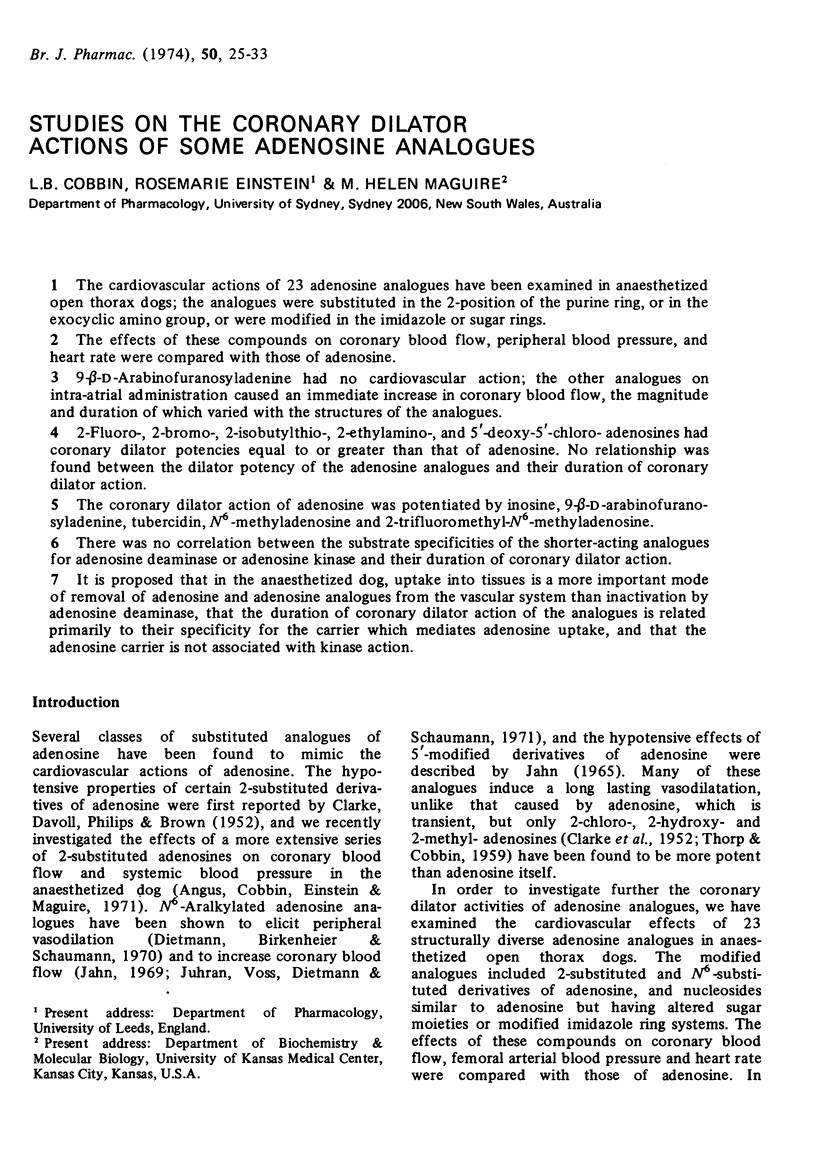
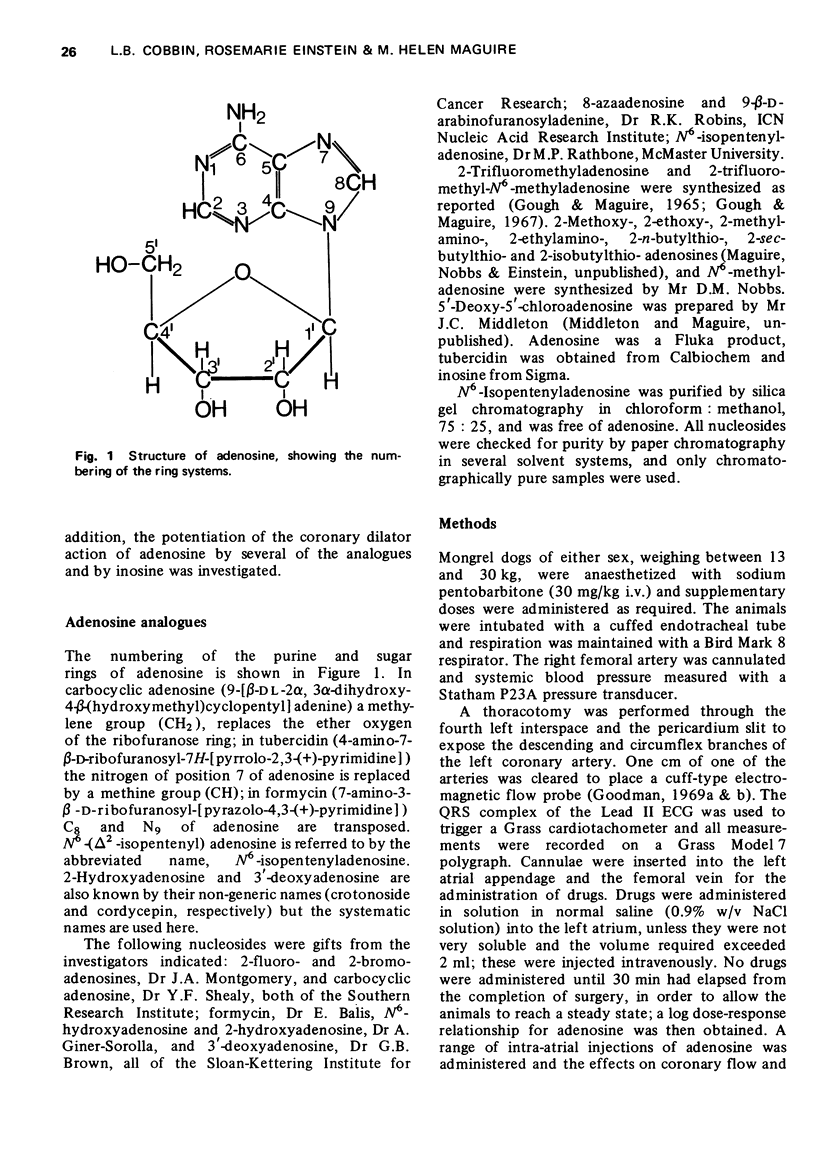
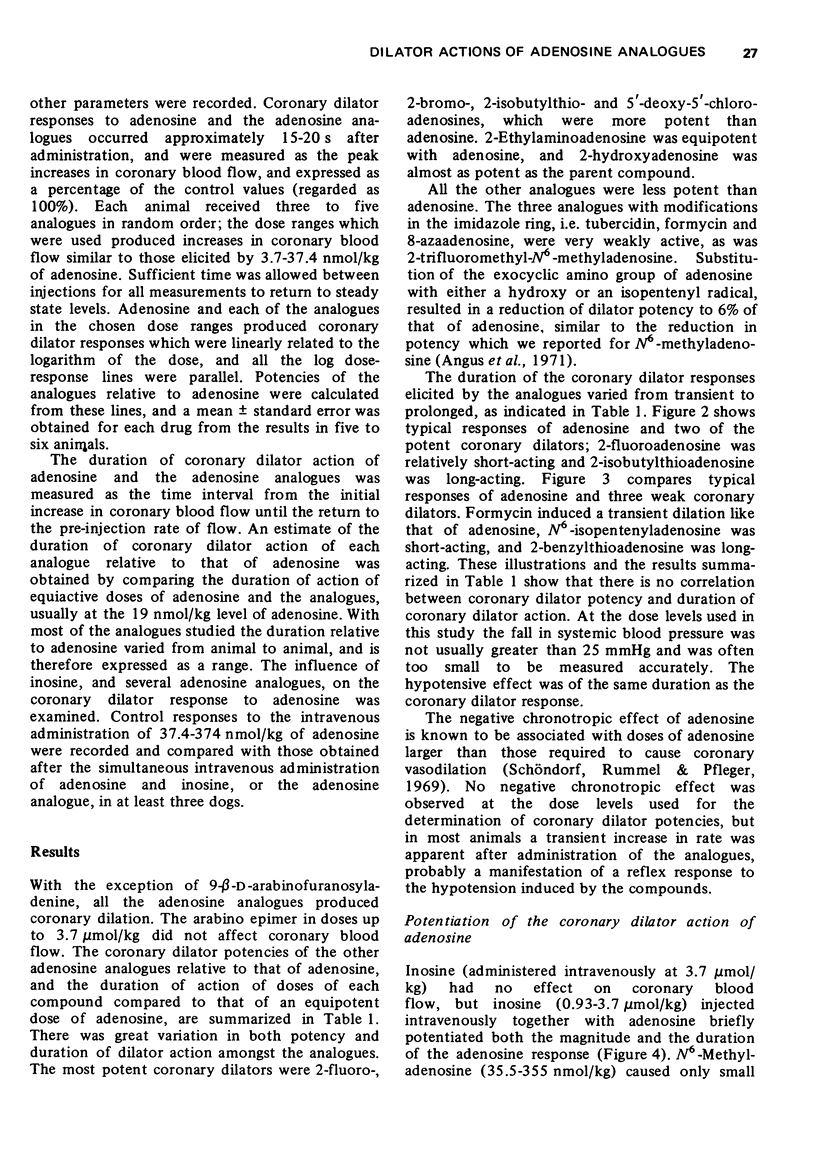
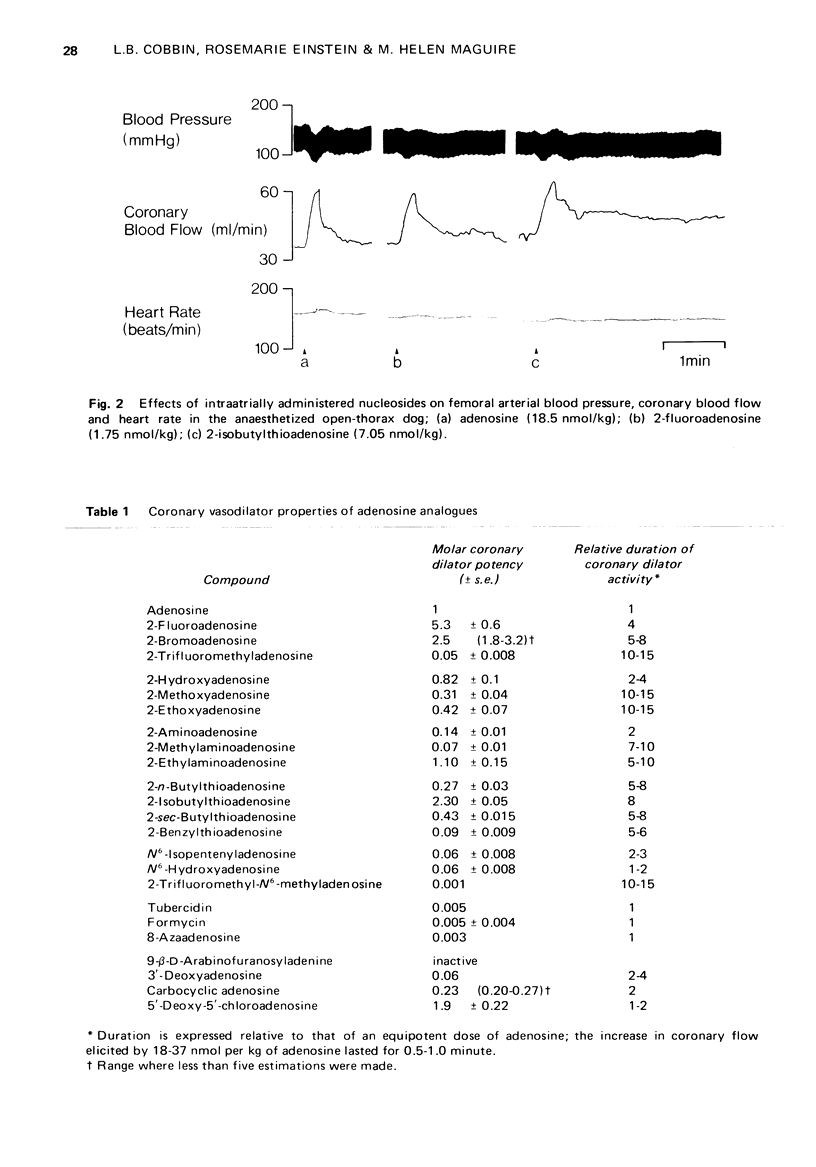
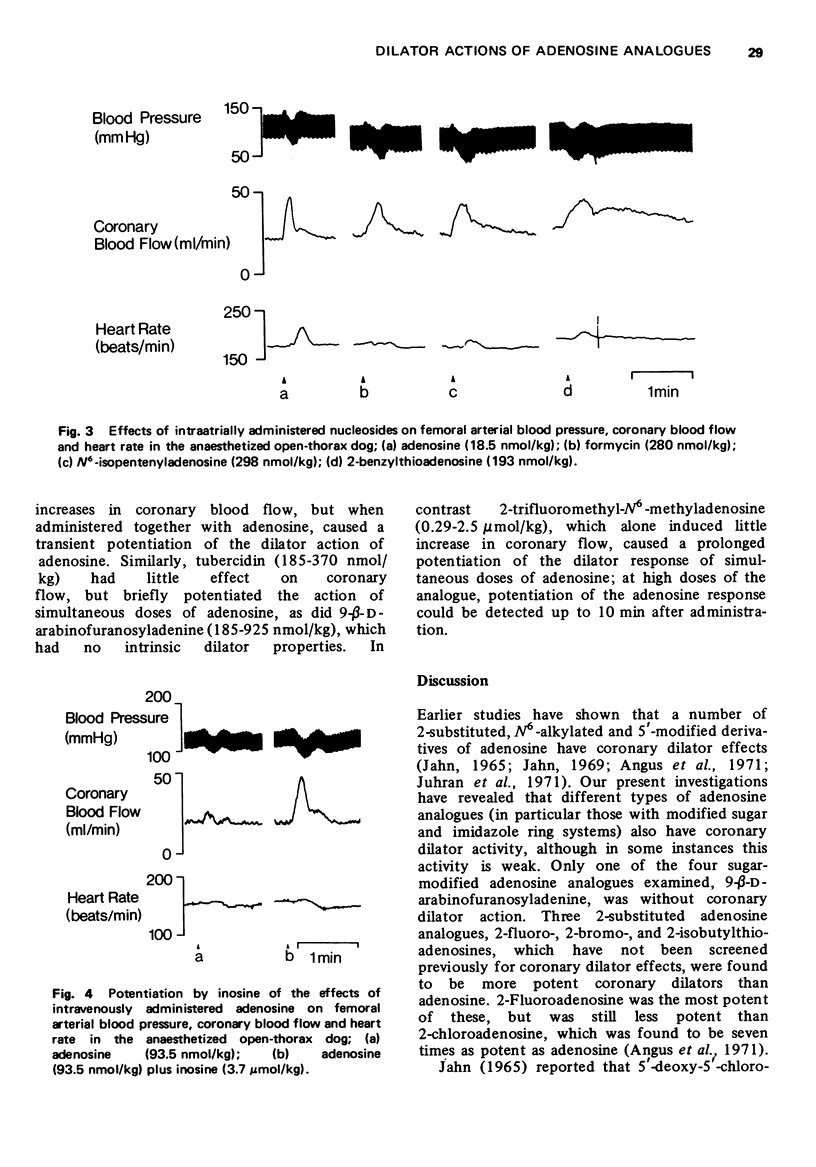
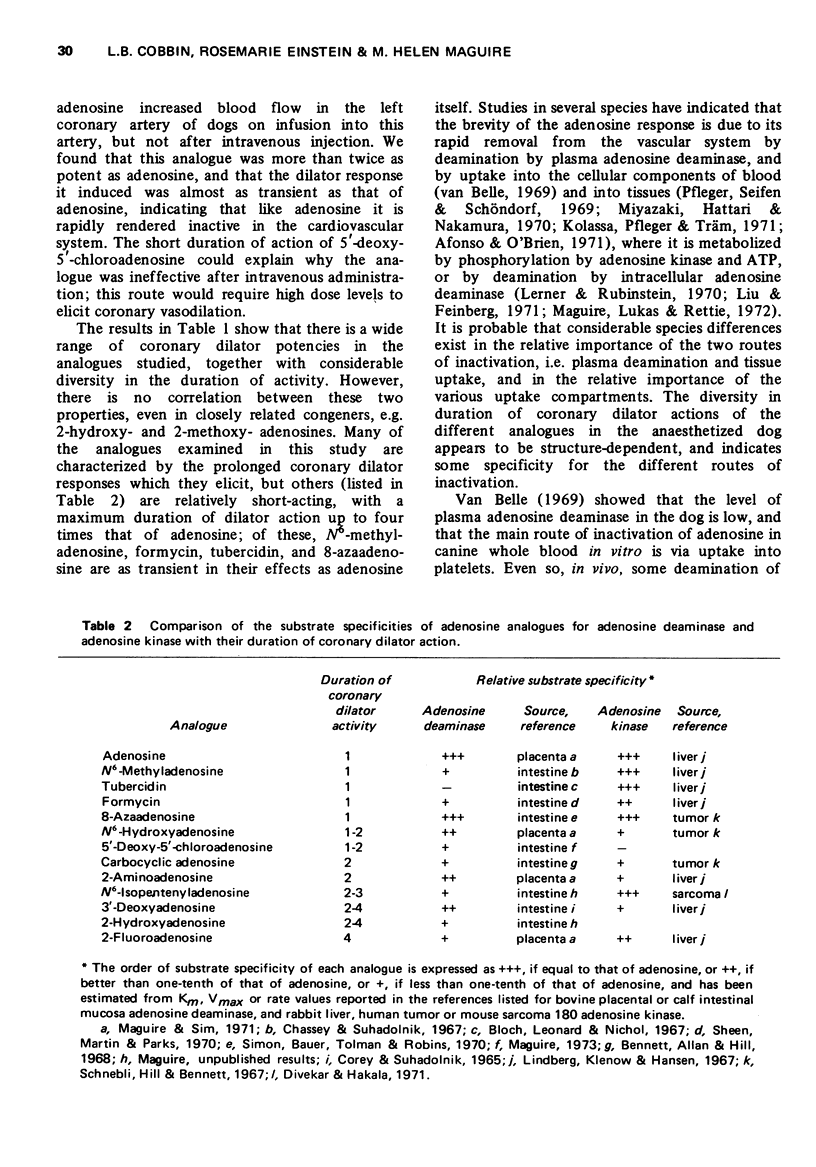
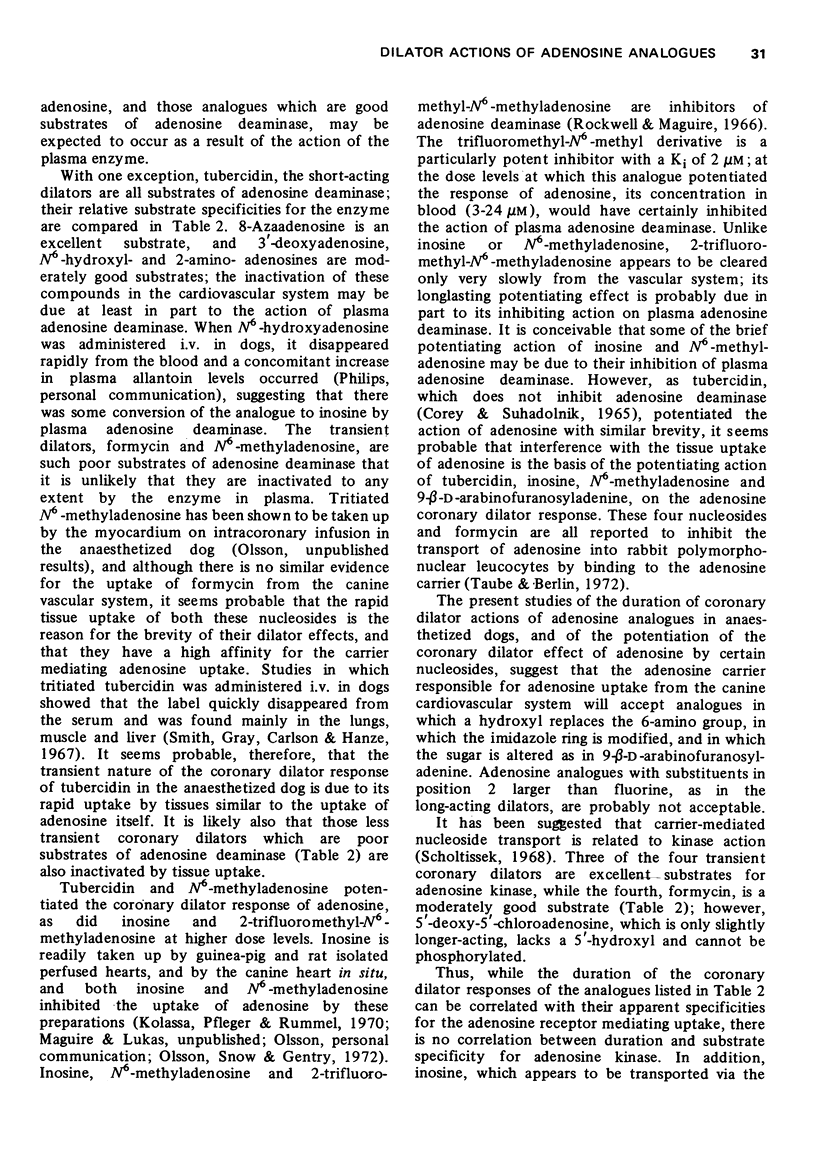
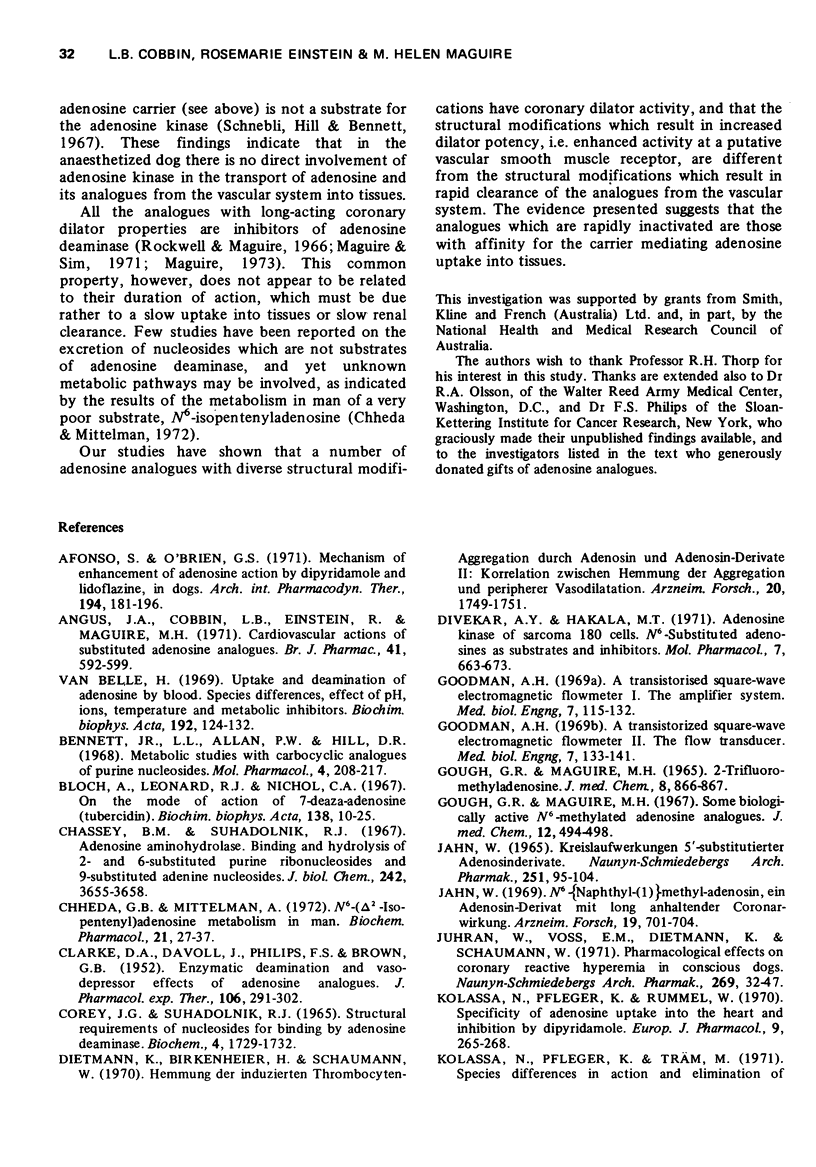
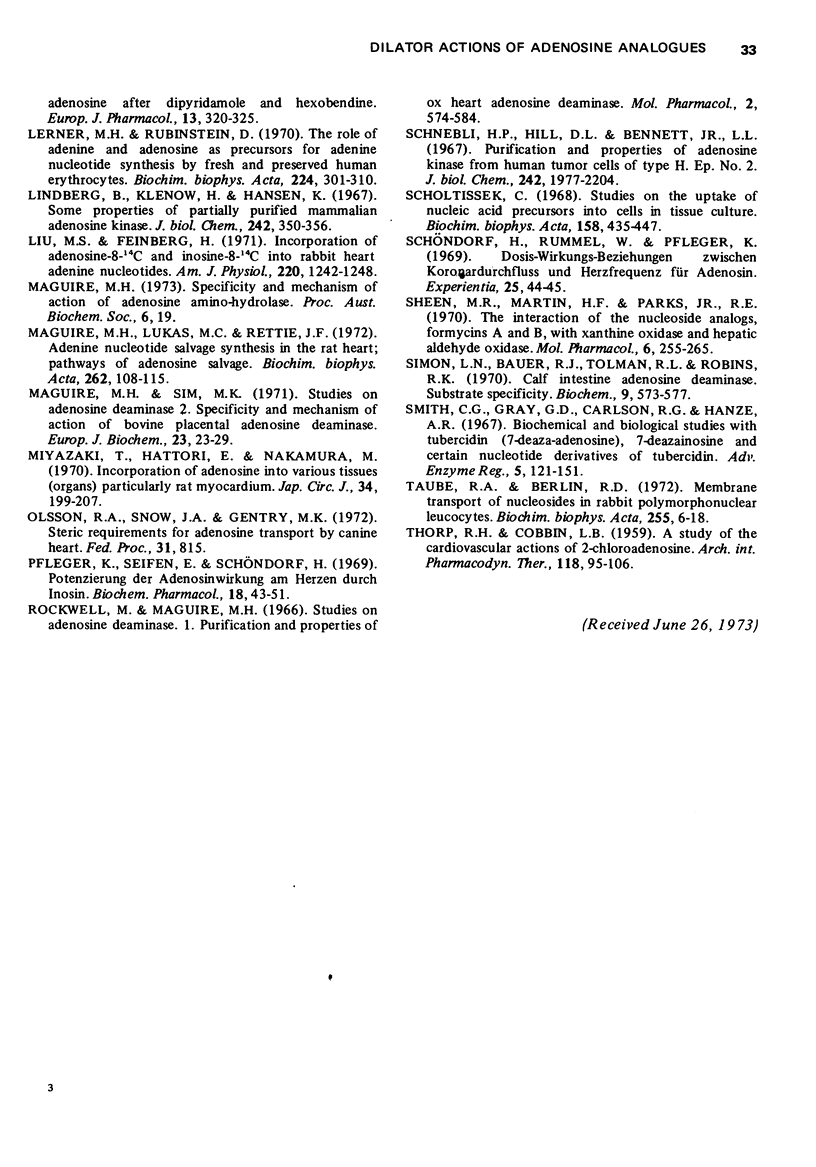
Selected References
These references are in PubMed. This may not be the complete list of references from this article.
- Afonso S., O'Brien G. S. Mechanism of enchancement of adenosine action by dipyridamole and lidoflazine, in dogs. Arch Int Pharmacodyn Ther. 1971 Nov;194(1):181–196. [PubMed] [Google Scholar]
- Angus J. A., Cobbin L. B., Einstein R., Maguire M. H. Cardiovascular actions of substituted adenosine analogues. Br J Pharmacol. 1971 Apr;41(4):592–599. doi: 10.1111/j.1476-5381.1971.tb07067.x. [DOI] [PMC free article] [PubMed] [Google Scholar]
- Bennett L. L., Jr, Allan P. W., Hill D. L. Metabolic studies with carbocyclic analogs of purine nucleosides. Mol Pharmacol. 1968 May;4(3):208–217. [PubMed] [Google Scholar]
- Bloch A., Leonard R. J., Nichol C. A. On the mode of action of 7-deaza-adenosine (tubercidin). Biochim Biophys Acta. 1967 Mar 29;138(1):10–25. doi: 10.1016/0005-2787(67)90581-3. [DOI] [PubMed] [Google Scholar]
- CLARKE D. A., DAVOLL J., PHILIPS F. S., BROWN G. B. Enzymatic deamination and vasodepressor effects of adenosine analogs. J Pharmacol Exp Ther. 1952 Nov;106(3):291–302. [PubMed] [Google Scholar]
- Chassy B. M., Suhadolnik R. J. Adenosine aminohydrolase. Binding and hydrolysis of 2-and 6-substituted purine ribonucleosides and 9-substituted adenine nucleosides. J Biol Chem. 1967 Aug 25;242(16):3655–3658. [PubMed] [Google Scholar]
- Chheda G. B., Mittelman A. N 6 -( 2 -isopentenyl)adenosine metabolism in man. Biochem Pharmacol. 1972 Jan;21(1):27–37. doi: 10.1016/0006-2952(72)90247-x. [DOI] [PubMed] [Google Scholar]
- Dietmann K., Birkenheier H., Schaumann W. Hemmung der induzierten Thrombocyten-Aggregation durch Adenosin und Adenosin-Derivate. 2. Korrelation zwischen Hemmung der Aggregation und peripherer Vasodilatation. Arzneimittelforschung. 1970 Nov;20(11):1749–1751. [PubMed] [Google Scholar]
- Divekar A. Y., Hakala M. T. Adenosine kinase of sarcoma 180 cells N 6 -substituted adenosines as substrates and inhibitors. Mol Pharmacol. 1971 Nov;7(6):663–673. [PubMed] [Google Scholar]
- Goodman A. H. A transistorized squarewave electromagnetic flowmeter--I. The amplifier system. Med Biol Eng. 1969 Mar;7(2):115–132. doi: 10.1007/BF02474170. [DOI] [PubMed] [Google Scholar]
- Goodman A. H. A transistorized squarewave electromagnetic flowmeter--II. The flow transducer. Med Biol Eng. 1969 Mar;7(2):133–141. doi: 10.1007/BF02474171. [DOI] [PubMed] [Google Scholar]
- Gough G., Maguire M. H. 2-Trifluoromethyladenosine. J Med Chem. 1965 Nov;8(6):866–867. doi: 10.1021/jm00330a032. [DOI] [PubMed] [Google Scholar]
- Gough G., Maguire M. H., Michal F. 2-chloroadenosine 5'-phosphate and 2-chloroadenosine 5'-diphosphate, pharmacologically active nucleotide analogs. J Med Chem. 1969 May;12(3):494–498. doi: 10.1021/jm00303a604. [DOI] [PubMed] [Google Scholar]
- Jahn W. Kreislaufwirkungen 5'-substituierter Adenosinderivate. Naunyn Schmiedebergs Arch Exp Pathol Pharmakol. 1965 Jun 1;251(1):95–104. [PubMed] [Google Scholar]
- Jahn W. N6-(Naphthyl-(1))-methyl-adenosin, ein Adenosin-Derivat mit lang anhaltender Coronarwirkung. Arzneimittelforschung. 1969 May;19(5):701–704. [PubMed] [Google Scholar]
- Kolassa N., Pfleger K., Rummel W. Specificity of adenosine uptake into the heart and inhibition by dipyridamole. Eur J Pharmacol. 1970 Mar;9(3):265–268. doi: 10.1016/0014-2999(70)90221-9. [DOI] [PubMed] [Google Scholar]
- Kolassa N., Pfleger K., Träm M. Species differences in action and elimination of adenosine after dipyridamole and hexobendine. Eur J Pharmacol. 1971;13(3):320–325. doi: 10.1016/0014-2999(71)90221-4. [DOI] [PubMed] [Google Scholar]
- Lerner M. H., Rubinstein D. The role of adenine and adenosine as precursors for adenine nucleotide synthesis by fresh and preserved human erythrocytes. Biochim Biophys Acta. 1970 Dec 14;224(2):301–310. doi: 10.1016/0005-2787(70)90563-0. [DOI] [PubMed] [Google Scholar]
- Lindberg B., Klenow H., Hansen K. Some properties of partially purified mammalian adenosine kinase. J Biol Chem. 1967 Feb 10;242(3):350–356. [PubMed] [Google Scholar]
- Liu M. S., Feinberg H. Incorporation of adenosine-8-14/C and inosine-8-14C into rabbit heart adenine nucleotides. Am J Physiol. 1971 May;220(5):1242–1248. doi: 10.1152/ajplegacy.1971.220.5.1242. [DOI] [PubMed] [Google Scholar]
- Maguire M. H., Lukas M. C., Rettie J. F. Adenine nucleotide salvage synthesis in the rat heart; pathways of adnosine salvage. Biochim Biophys Acta. 1972 Mar 14;262(2):108–115. doi: 10.1016/0005-2787(72)90223-7. [DOI] [PubMed] [Google Scholar]
- Maguire M. H., Sim M. K. Studies on adenosine deaminase. 2. Specificity and mechanism of action of bovine placental adenosine deaminase. Eur J Biochem. 1971 Nov 11;23(1):22–29. doi: 10.1111/j.1432-1033.1971.tb01587.x. [DOI] [PubMed] [Google Scholar]
- Miyazaki T., Hattori E., Nakamura M. [Incorporation of adenosine into various tissues, particularly into the myocardium]. Jpn Circ J. 1970 Mar;34(3):199–207. doi: 10.1253/jcj.34.199. [DOI] [PubMed] [Google Scholar]
- Pfleger K., Seifen E., Schöndorf H. Potenzierung der Adenosinwirkung am Herzen durch Inosin. Biochem Pharmacol. 1969 Jan;18(1):43–51. doi: 10.1016/0006-2952(69)90007-0. [DOI] [PubMed] [Google Scholar]
- Rockwell M., Maguire M. H. Studies on adenosine deaminase. I. Purification and properties of ox heart adenosine deaminase. Mol Pharmacol. 1966 Nov;2(6):574–584. [PubMed] [Google Scholar]
- Scholtissek C. Studies on the uptake of nucleic acid precursors into cells in tissue culture. Biochim Biophys Acta. 1968 Jun 24;158(3):435–447. doi: 10.1016/0304-4165(68)90297-3. [DOI] [PubMed] [Google Scholar]
- Sheen M. R., Martin H. F., Parks R. E., Jr The interaction of the nucleoside analogues, formycins A and B, with xanthine oxidase and hepatic aldehyde oxidase. Mol Pharmacol. 1970 May;6(3):255–265. [PubMed] [Google Scholar]
- Simon L. N., Bauer R. J., Tolman R. L., Robins R. K. Calf intestine adenosine deaminase. Substrate specificity. Biochemistry. 1970 Feb 3;9(3):573–577. doi: 10.1021/bi00805a018. [DOI] [PubMed] [Google Scholar]
- Smith C. G., Gray G. D., Carlson R. G., Hanze A. R. Biochemical and biological studies with tubercidin (7-deaza-adenosine), 7-deazainosine and certain nucleotide derivatives of tubercidin. Adv Enzyme Regul. 1967;5:121–151. doi: 10.1016/0065-2571(67)90013-1. [DOI] [PubMed] [Google Scholar]
- THORP R. H., COBBIN L. B. A study of the cardiovascular actions of 2-chloroadenosine. Arch Int Pharmacodyn Ther. 1959 Jan 1;118(1-2):95–106. [PubMed] [Google Scholar]
- Taube R. A., Berlin R. D. Membrane transport of nucleosides in rabbit polymorphonuclear leukocytes. Biochim Biophys Acta. 1972 Jan 17;255(1):6–18. doi: 10.1016/0005-2736(72)90003-x. [DOI] [PubMed] [Google Scholar]
- Van Belle H. Uptake and deamination of adenosine by blood. Species differences, effect of pH, ions, temperature and metabolic inhibitors. Biochim Biophys Acta. 1969 Oct 7;192(1):124–132. doi: 10.1016/0304-4165(69)90017-8. [DOI] [PubMed] [Google Scholar]


